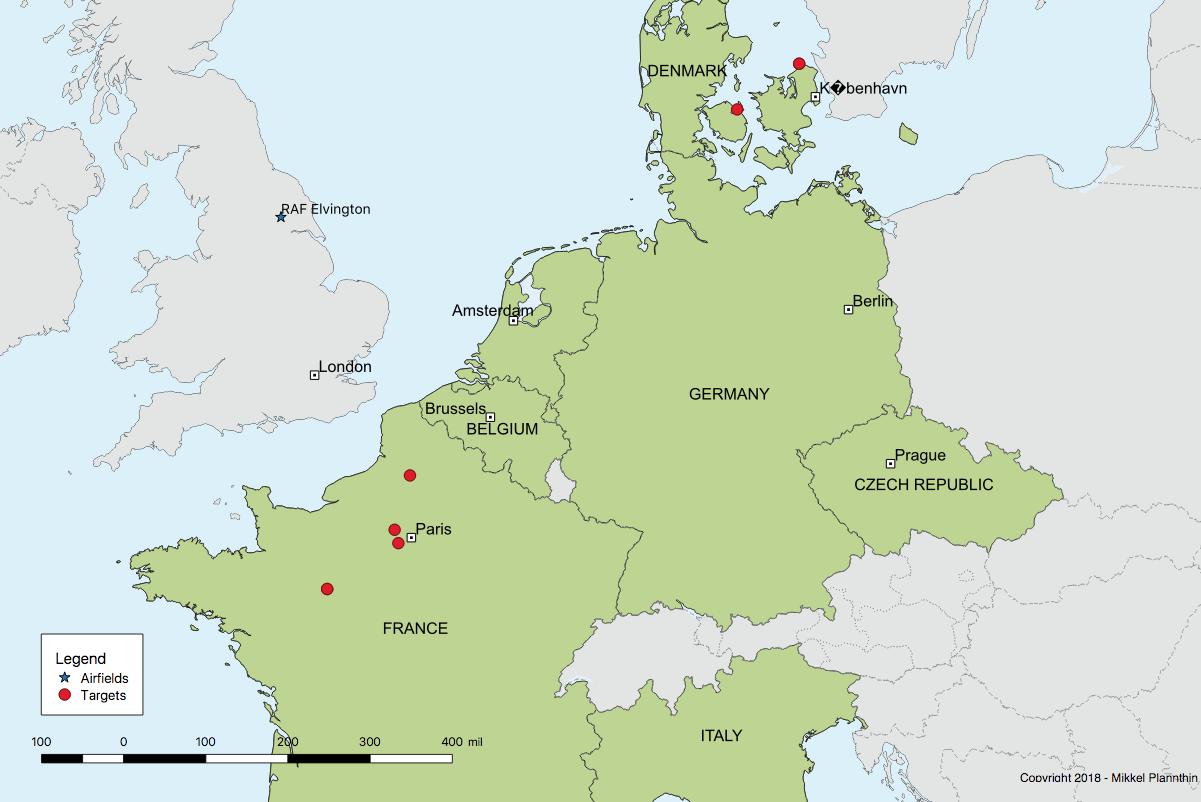Plt Off. John Norgaard
(1909 - 1944)
Profile
John Norgaard is one of the Danes who volunteers for the Royal Canadian Air Force. He is killed in the spring of 1944.
John Norgaard was born as Johannes Nørgaard on 15 October 1909 in Brøndsted, Denmark. He was the son of blacksmith Hans Nørgaard and Helga Anna Camilla Nørgaard (née Heintze).[1]
He was trained as a dairyman during the 1920s. In 1930, he emigrated to Canada. He lived in Toronto, ON, for a number of years, and later in Thuro, NS. At the time of enlistment, he was working as a painter.[2]Royal Canadian Air Force
Norgaard enlisted in the Royal Canadian Air Force at No. 16 Recruit Centre, Halifax, NS, on 9 November 1942. On 2 December 1942, he was taken on strength as Aircraftman 2nd Class (R 183245) at No. 5 Manning Depot, Lachine, Quebec, for Ground Defence Training, but he was admitted to the hospital on 24 December 1942 until 6 February 1943 due to a fractured small toe.
He commenced training as Air Gunner at No. 12 Aircraft Inspection Depot/Detachment, Toronto, on 25 February 1943. He was then posted to No. 23 Pre-Aircrew Education Detachment at the University of Toronto from 18 April to 13 May 1943. He was trained in English, mathematics and signals. He proceeded to No. 1 Air Gunners Ground Training School on 14 May 1943.
On 26 June 1943, he was promoted to Leading Aircraftman and, from 28 June to 6 August 1943, he was enrolled in the course No. 57 at No. 9 Bombing & Gunnery School in Mont Joli, Quebec. He obtained a 71/100 score and was evaluated as “moderately suitable" for further training even if the evaluation also states, that he displayed plenty of initiative and was very keen, dependable and a good leader. At the end of the course he was appointed sergeant and awarded the air gunner’s badge. Following a short leave, he was posted to No. 1 “Y" Depot, Halifax, for overseas duties. He embarked in Halifax on the 26 August 1943 and disembarked in UK on 1 September 1943.He was at No. 3 Personnel Reception Centre until 21 September 1943.
On 21 September 1943 he was posted to No. 20 Operational Training Unit, Lossiemouth. He was enrolled in course No. 80 at this unit from 23 August to 9 November 1943. According to the training report he was an average air gunner. Following a short attachment to No. 4 Group Battle School, from 15 to 25 November 1943, he was posted to No. 1663 Heavy Conversion Unit to follow the Boulton Paul Turret Course to prepare him for flying Halifax. On 15 January 1944 he was authorised to wear the Canadian Volunteer Service Medal Ribbon and Maple Leaf Emblem.[3]
Operational Service
Norgaard was posted to 77 Sqn on 18 February 1944 as part of Flg Off. P. C. Edward’s crew. This squadron was flying Halifax bombers out of RAF Elvington.
During the first three months of 1944, Bomber Command placed more than 4,000 mines in gardening operations. Norgaard took part in these operations. On 22 February, his crew took off the first mine-laying operation, but they were recalled to base before they reached the target. Only two days later, on 24-25 February 1944, the target was Danish waters. Taking off from RAF Elvington in Halifax Mk. II (LK667/KM-A) at 1712 hours, they crossed the Danish coast at Fanø to reach the target (Kattegat, just north of Zealand) at 2057 hours. Unfortunately, the operation was unsuccessful due to bad weather, and the mines were brought back to base. One can only guess what went through John Norgaard’s mind, flying over his birth country fourteen years after he left it. Norgaard carried out a third gardening operation the following night.

In the spring of 1944, the Allies were preparing for the coming invasion in Northern France. An important part of these preparations were attacks on railway targets in France and Belgium. On 3 March 1944, John Nørgaard participated in the first of four bombing missions over the north of France. The target was the S.N.C.A. aircraft factory in Meulan-Les-Mureaux 15 miles north-west of Paris. Three days later, the target was Trappes. The following nights, 7–8 March, and 13–14 March, Norgaard participated in attacks on Le Mans.[4]
Two days later, both Norgaard and another Danish airman, Sten Lindhard, were part of the operation attacking the marshalling yards at Amiens. Norgaard’s crew took off from RAF Station Elvington in Halifax V LK667/KM-A at 1812 hours. At about 10 p.m., the aircraft crashed 500 meters north of Longueau, in a swamp not far from the railway station. The aircraft broke up completely when it hit the ground. It is unknown why the aircraft crashed. According to a document in Norgaard’s service record, the aircraft may have crashed due to a mid-air collision, but this cannot be confirmed by other sources. The crew — Fg Off. P. C. Edwards (pilot captain, J.10600), Sgt R. J. Service (F/E, 1044703), Flg Off. A. E. Guthrie (N, J.24010), Flg Off. J. Duncan (A/B, J.26545), Sgt D. W. J. Smith (WOP, 1323374), Sgt J. Norgaard (AG, R.183245), and Sgt E. H. Orchard (AG, 926349) — were killed.
On 16 November 1946 the Operational Wings and Certificate in recognition of the gallant service of Norgaard was send to his father in Denmark.[5]
Norgaard is commemorated at the St. Pierre Cemetery in Amiens, France.[6]Endnotes
[1] DNA: Parish record, Gauerslund Sogn
[2] Ancestry.com: Canadian Passenger Lists, 1865-1935; LAC: R112/30696, service record
[3] LAC: R112/30696, service record
[4] NA: AIR 27/657; Middlebrook and Everitt, 2011
[5] LAC: R112/30696, service record
[6] www.cwgc.org